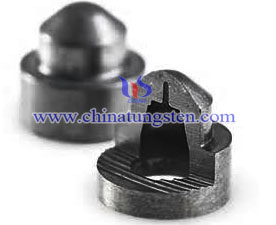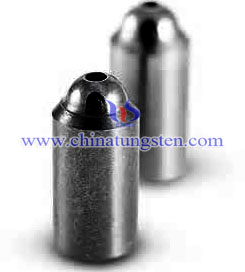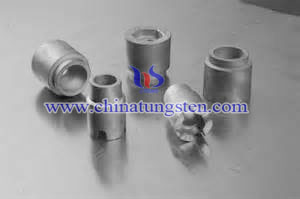Extraction of Ferrotungsten from Ores with Low WO3 Content
- Details
- Category: Tungsten Information
- Published on Wednesday, 02 September 2015 17:06
Aluminothermic SHS reaction was explored as a possible route to manufacturing ferrotungsten alloy (FeW) from an ore concentrate. Changing green composition, i.e. the amount (x) of Al, it was possible to control the composition and microstructure of resultant alloys. Regardless of green composition, the final product always consisted of three phases: W, FeW, and Fe-Al-W. Compositions of the W and FeW phases were independent of x, while the Al content of the Fe-Al-W phase grew with increasing x. An alloy most closely fitting specification requirements was synthesized from green mixtures with a slightly lower amount of Al as compared to a stoichiometric one.
Tungsten Powder Manufacturer & Supplier: Chinatungsten Online - www.tungsten-powder.com
Tel.: 86 592 5129696; Fax: 86 592 5129797
Email: sales@chinatungsten.com
Tungsten & Molybdenum Information Bank: http://i.chinatungsten.com
Tungsten News & Tungsten Prices, 3G Version: http://3g.chinatungsten.com
Molybdenum News & Molybdenum Price: http://news.molybdenum.com.cn
Tungsten Carbide Tipped (TCT) Core Drills
- Details
- Category: Tungsten Information
- Published on Wednesday, 02 September 2015 17:04
Tungsten Carbide Manufacturer & Supplier: Chinatungsten Online - http://www.tungsten-carbide.com.cn
Tel.: 86 592 5129696; Fax: 86 592 5129797
Email: sales@chinatungsten.com
Tungsten & Molybdenum Information Bank: http://i.chinatungsten.com
Tungsten News & Tungsten Prices, 3G Version: http://3g.chinatungsten.com
Molybdenum News & Molybdenum Price: http://news.molybdenum.com.cn
Tungsten Carbide Annular Cutter(Core Drill) General Concept
- Details
- Category: Tungsten Information
- Published on Wednesday, 02 September 2015 16:55
Tungsten Carbide Manufacturer & Supplier: Chinatungsten Online - http://www.tungsten-carbide.com.cn
Tel.: 86 592 5129696; Fax: 86 592 5129797
Email: sales@chinatungsten.com
Tungsten & Molybdenum Information Bank: http://i.chinatungsten.com
Tungsten News & Tungsten Prices, 3G Version: http://3g.chinatungsten.com
Molybdenum News & Molybdenum Price: http://news.molybdenum.com.cn
Tungsten Carbide Nozzle Grain Growth
- Details
- Category: Tungsten Information
- Published on Wednesday, 02 September 2015 16:54
The grain growth problem, which is an inevitable problem during WC-Co cemented carbide nozzles liquid phase sintering process. While there are two main patterns of the grain growth, one is WC particles growing uniformly, approach the growth is constant. The other one is some WC grains is growing in advance. However, these two patterns of the grain growth is not independent, and they can be existing and occurring in the same time.
Generally, to control the constant growth of grains and avoid the regional growth, which is able to ensure the density of the material. During the sintering process, the regional WC grain growth and become thick, which is the source of tungsten carbide nozzle cracks appearing. Therefore, adds appropriate amount of the WC powder grain growth inhibitors, which can be beneficial for suppressing the growth of grain and improving the lifespan.
Tungsten Carbide Manufacturer & Supplier: Chinatungsten Online - http://www.tungsten-carbide.com.cn
Tel.: 86 592 5129696; Fax: 86 592 5129797
Email: sales@chinatungsten.com
Tungsten & Molybdenum Information Bank: http://i.chinatungsten.com
Tungsten News & Tungsten Prices, 3G Version: http://3g.chinatungsten.com
Molybdenum News & Molybdenum Price: http://news.molybdenum.com.cn
Tungsten Carbide Nozzle Plasma Activated Sintering Technology II
- Details
- Category: Tungsten Information
- Published on Wednesday, 02 September 2015 16:52
The four steps are applies an axial pressure to the powder, produces plasma for activation of the powder particles through pulse current discharge, with a direct current resistance of the sample is heated up to the required temperature and maintained for a certain time and the stress relief step. The most obvious difference between SPS and PAS is the third step, which SPS is heating by pulse current and it does not use DC as hot source during the whole sintering process.
Compared to common hot pressed sintering, conventional sintering and hot isostatic pressing (HIP), tungsten carbide nozzle plasma activated sintering technology has many advantages. First of all, it uses a DC to heat powder material and a graphite mold directly, and uses switching DC pulse voltage to generate high-temperature plasma among the powder particles or between voids. Therefore, the operation will be more convenient and more precise in sintering energy controlling. And the inside of material has been heated uniformly, the heat transfer efficiency improved, the material densification improved.

Tungsten Carbide Manufacturer & Supplier: Chinatungsten Online - http://www.tungsten-carbide.com.cn
Tel.: 86 592 5129696; Fax: 86 592 5129797
Email: sales@chinatungsten.com
Tungsten & Molybdenum Information Bank: http://i.chinatungsten.com
Tungsten News & Tungsten Prices, 3G Version: http://3g.chinatungsten.com
Molybdenum News & Molybdenum Price: http://news.molybdenum.com.cn
Tungsten Carbide Nozzle Plasma Activated Sintering Technology
- Details
- Category: Tungsten Information
- Published on Wednesday, 02 September 2015 16:50
Plasma activated sintering (for short PAS), which takes advantage of switching DC pulse voltage generated high-temperature plasma among the powder particles or between voids. The plasma is a high-temperature, high reactive ionized gas conductance, and is capable of producing high-temperature about 4000-10000K.
So that the plasma can remove the impurities and gas adsorption of the powder grain surface quickly, which promote the substance spreading and moving, accelerating the sintering process and improving the efficiency. It is similar to self-propagation high-temperature synthesis (SHS) and microwave sintering, which is a kind of process that using the heat of inside powder for instant sintering. In general, tungsten carbide nozzle plasma activated sintering technology has four main steps.

Tungsten Carbide Manufacturer & Supplier: Chinatungsten Online - http://www.tungsten-carbide.com.cn
Tel.: 86 592 5129696; Fax: 86 592 5129797
Email: sales@chinatungsten.com
Tungsten & Molybdenum Information Bank: http://i.chinatungsten.com
Tungsten News & Tungsten Prices, 3G Version: http://3g.chinatungsten.com
Molybdenum News & Molybdenum Price: http://news.molybdenum.com.cn
Tungsten Carbide Nozzle Spark Plasma Sintering Technology
- Details
- Category: Tungsten Information
- Published on Wednesday, 02 September 2015 16:48
During spark plasma sintering (SPS) process, the electrode through the DC pulse currents and generated discharge plasma, which makes individual particles uniformly distribute, generate Joule heat and particle surface activation. SPS process is similar to microwave sintering, which takes advantage of the self-heating effect inside for sintering. It can be considered as a process that combines the particle discharge, conductive heat and the pressure. Except heating and pressure two promoting factors, SPS technology can make partial melting of the surface and the surface of the material flaking through effective discharge produced local high temperature particles; And removing the impurities of powder grain surface or adsorption by the sputtering of high-temperature plasma and the impact of discharge.

Tungsten Carbide Manufacturer & Supplier: Chinatungsten Online - http://www.tungsten-carbide.com.cn
Tel.: 86 592 5129696; Fax: 86 592 5129797
Email: sales@chinatungsten.com
Tungsten & Molybdenum Information Bank: http://i.chinatungsten.com
Tungsten News & Tungsten Prices, 3G Version: http://3g.chinatungsten.com
Molybdenum News & Molybdenum Price: http://news.molybdenum.com.cn
Tungsten Carbide Milling Cutter Nomenclature
- Details
- Category: Tungsten Information
- Published on Wednesday, 02 September 2015 16:13
Tel.: 86 592 5129696; Fax: 86 592 5129797
Email: sales@chinatungsten.com
Tungsten & Molybdenum Information Bank: http://i.chinatungsten.com
Tungsten News & Tungsten Prices, 3G Version: http://3g.chinatungsten.com
Tungsten Carbide Drill Bits Among Others- A Classification of Drills By Materials
- Details
- Category: Tungsten Information
- Published on Wednesday, 02 September 2015 11:39
Tel.: 86 592 5129696; Fax: 86 592 5129797
Email: sales@chinatungsten.com
Tungsten & Molybdenum Information Bank: http://i.chinatungsten.com
Tungsten News & Tungsten Prices, 3G Version: http://3g.chinatungsten.com
Molybdenum News & Molybdenum Price: http://news.molybdenum.com.cn
API Standards For Rock Bits And PDC Bits
- Details
- Category: Tungsten Information
- Published on Wednesday, 02 September 2015 11:35
API standards, as established by the American Petroleum Institute, enable drilling professionals the world over to communicate clearly.
American Petroleum Institute Standards for PDC and Rock Bit Tolerances
|
Bit Size (In.) |
O.D. Tolerance (In.) |
O.D. Tolerance (In.) |
|
6 3/4" and smaller |
-0.015 to +0.00 PDC |
-0.0 to +1/32 Rock Bit |
|
6 25/32" to 9" |
-0.020 to +0.00 PDC |
-0.0 to +1/32 Rock Bit |
|
9 1/32" to 13 3/4" |
-0.030 to +0.00 PDC |
-0.0 to +1/32 Rock Bit |
|
17 17/32" and larger |
-0.063 to +0.00 PDC |
-0.0 to +3/32 Rock Bit |
|
9 1/32" to 13 3/4" |
-0.030 to +0.00 PDC |
-0.0 to +1/32 Rock Bit |
|
13 25/32" to 17 1/2" |
-0.045 to +0.00 PDC |
-0.0 to +1/16 Rock Bit |
PDC bits are gauged by either a "go" gauge or a "no go" gauge.
A "no go"gauge is used to ensure a bit is not smaller than allowed and, as the name implies, it should not go or slip down the entire length of the bit. A "go gauge ensures a bit is not larger than allowed and should slip down the entire bit.
Rock Bit Size and API Standard Connection
3 1/2" to 4 1/2" drill bits - 2 3/8" API Reg. pin
4 5/8" to 5 1/2" drill bits - 2 7/8" API Reg. pin
5 5/8" to 7 3/8" drill bits - 3 1/2" API Reg. pin
Number of Nozzles
|
Nozzle |
1 |
2 |
3 |
4 |
5 |
6 |
7 |
8 |
|
7 |
.0376 |
.0752 |
.1127 |
.1503 |
.1877 |
.2255 |
.2631 |
.3007 |
|
8 |
.0491 |
.0982 |
.1473 |
.1963 |
.2454 |
.2945 |
.3435 |
.3927 |
|
9 |
.0621 |
.1242 |
.1864 |
.2485 |
.3106 |
.3728 |
.4249 |
.4970 |
|
10 |
.0767 |
.1534 |
.2301 |
.3060 |
.3835 |
.4602 |
.5369 |
.6136 |
|
11 |
.0928 |
.1856 |
.2784 |
.3712 |
.4640 |
.5568 |
.6496 |
.7424 |
|
12 |
.1104 |
.2209 |
.3313 |
.4418 |
.5522 |
.6627 |
.7731 |
.8836 |
|
13 |
.1296 |
.2592 |
.3889 |
.5185 |
.6481 |
.7777 |
.9073 |
1.0370 |
|
14 |
.1503 |
.3007 |
.4510 |
.6013 |
.7517 |
.9020 |
1.0523 |
1.2026 |
|
15 |
.1726 |
.3451 |
.5177 |
.6903 |
.8629 |
1.0354 |
1.2080 |
1.3806 |
|
16 |
.1963 |
.3927 |
.5890 |
.7854 |
.9817 |
1.1781 |
1.3744 |
1.5708 |
|
18 |
.2485 |
.4970 |
.7455 |
.9940 |
1.2425 |
1.4910 |
1.7395 |
1.9880 |
|
20 |
.3068 |
.6136 |
.9204 |
1.2272 |
1.5340 |
1.8408 |
2.1476 |
2.4544 |
|
|
.3712 |
.7424 |
1.1137 |
1.4849 |
1.8561 |
2.2273 |
2.5986 |
2.9698 |
Tungsten Carbide Manufacturer & Supplier: Chinatungsten Online - http://www.tungsten-carbide.com.cn
Tel.: 86 592 5129696; Fax: 86 592 5129797
Email: sales@chinatungsten.com
Tungsten & Molybdenum Information Bank: http://i.chinatungsten.com
Tungsten News & Tungsten Prices, 3G Version: http://3g.chinatungsten.com
Molybdenum News & Molybdenum Price: http://news.molybdenum.com.cn



 sales@chinatungsten.com
sales@chinatungsten.com